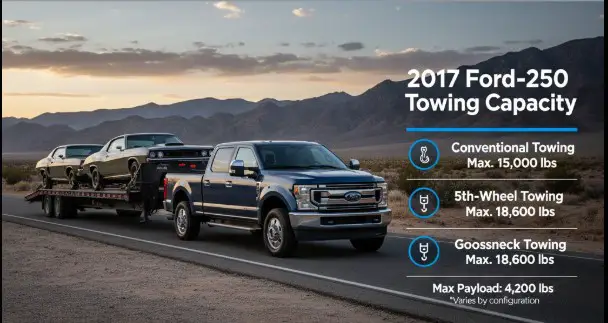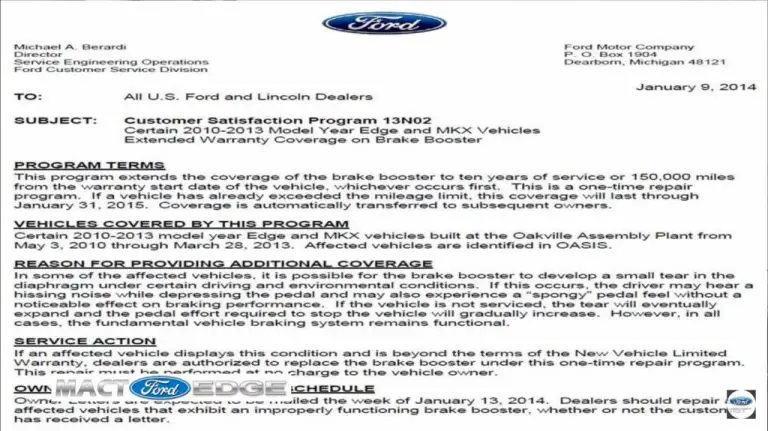2017 Ford F-250 Towing Capacity Chart: The Complete Guide
Unlocking the 2017 Super Duty’s True Towing Power
The 2017 Ford F-250 marked a revolutionary step in the heavy-duty truck segment. It was the first model year of the redesigned Super Duty platform, which introduced a high-strength, military-grade aluminum-alloy body and a frame built from 95% high-strength steel. This engineering feat reduced the truck’s curb weight while dramatically increasing frame rigidity, fundamentally altering its towing and payload capabilities.
However, this redesign also created significant confusion in the market. Official Ford literature for the 2017 Super Duty promotes a maximum gooseneck towing capacity of 32,500 pounds. This figure is frequently misinterpreted. That class-leading number does not apply to the F-250. It is the maximum rating achievable only by a properly equipped F-450 with a dual-rear-wheel (DRW) configuration.
The F-250 is a single-rear-wheel (SRW) truck with a vastly different set of limitations. Ford’s official towing guides group all Super Duty models (F-250, F-350, F-450) together, leading with the highest possible number. This creates a dangerous knowledge gap for owners. The F-250’s actual maximum 5th-wheel towing capacity, for example, is 18,500 pounds—a staggering 14,000 pounds less than the widely advertised figure.
This guide provides the official, data-driven charts and analysis to correct these misconceptions and establish the realistic, safe towing limits for the 2017 F-250.
2017 Ford F-250 Super Duty
A Visual Guide to Towing & Payload Capacities
Max 5th Wheel Towing
18,600 lbs
(with 6.7L Diesel)
Max Payload
4,200 lbs
(with 6.2L Gas)
What Determines Your Towing Capacity?
Towing capacity isn’t one number. It’s a complex calculation based on several key components of your truck’s configuration. A change in any one of these can alter your max tow rating by thousands of pounds.
1. Engine Type
The 6.7L Power Stroke Diesel provides significantly more torque than the 6.2L V8 Gas.
2. Axle Ratio
A higher ratio (e.g., 4.30) provides more towing power, while a lower ratio (e.g., 3.55) is better for fuel economy.
3. Drivetrain & Cab
4×2 models can typically tow slightly more than 4×4 models due to less weight. Lighter Regular Cabs tow more than heavier Crew Cabs.
4. Hitch Type
5th Wheel / Gooseneck hitches connect in the bed, allowing for much higher capacities than a conventional bumper/receiver hitch.
Engine Power Comparison
The 2017 F-250 offered two powerful engines. The 6.7L Power Stroke V8 Diesel was the clear winner for towing, producing more than double the torque of its gasoline counterpart.
Conventional Towing (Receiver Hitch)
This chart shows the maximum conventional tow ratings. Note how the 6.7L Diesel consistently outperforms the 6.2L Gas, and how the higher 4.30 axle ratio boosts the gas engine’s performance significantly.
5th Wheel / Gooseneck Towing
For heavy-duty hauling, a 5th wheel or gooseneck hitch is required. This configuration unlocks the F-250’s highest tow ratings, especially when paired with the 6.7L Diesel engine.
2017 F-250 SRW Maximum Capacity Overview
This table provides a scannable baseline of the F-250’s true maximum capabilities, which are achieved only with very specific configurations.
| Towing Type | Maximum Capacity (lbs) | Required Configuration |
| Conventional (Hitch) | 18,000 lbs | 6.7L Diesel, 176″ WB, Weight-Distributing Hitch |
| 5th-Wheel/Gooseneck | 18,500 lbs | 6.7L Diesel, 4×2 Regular Cab |
| Maximum Payload | 4,200 lbs | 6.2L Gas, 4×2 Regular Cab |
This data immediately highlights a critical theme: the “max” ratings are for specific, often uncommon, truck configurations. For instance, the maximum payload rating is achieved with the lighter 6.2L gas engine, not the more powerful diesel—a counter-intuitive fact that will be explored in detail.
How to Find an Exact 2017 F-250 Towing Capacity in 3 Steps
A truck’s advertised “max towing capacity” is a theoretical number. The only rating that matters is the one calculated for a specific vehicle. This capacity is determined by its engine, axle ratio, cab type, drivetrain, and optional packages. The following three steps explain how any owner can find their truck’s precise rating.
Step 1: Read the “Door Sticker” (The Legal Limit)
The most important source of information for any truck owner is the Safety Compliance Certification Label. This sticker, located on the driver’s side door jamb, is the legal source of truth for the vehicle’s weight ratings. It contains two crucial pieces of information:
- GVWR (Gross Vehicle Weight Rating): This is the legal maximum weight the truck can be, including all passengers, cargo in the cab and bed, and the trailer’s pin or tongue weight.
- AXLE Code: This is a two-digit code that identifies the truck’s axle ratio and differential type, which is essential for using the towing charts.
Step 2: Identify The Engine (Gas vs. Diesel)
The powertrain is the most significant factor. The 2017 F-250 was available with two engine options:
- 6.7L Power Stroke V8 Turbo Diesel
- 6.2L “Boss” V8 Gas
Step 3: Decode The “AXLE” Code (The “Rosetta Stone”)
The two-digit “AXLE” code from the door sticker is the “secret” to using Ford’s official towing charts correctly. It identifies both the numerical gear ratio and the differential type (e.g., electronic locking).
An axle ratio is a torque multiplier. A “numerically higher” ratio (like 4.30) provides significantly more towing power and off-the-line performance, which is especially important for the gas engine. A “numerically lower” ratio (like 3.31) is geared for highway fuel economy and will have a lower tow rating.
As the 5th-wheel towing chart demonstrates, a 2017 F-250 6.2L Crew Cab 4×4 with the 3.73 axle is rated for 12,200 pounds. That exact same truck equipped with the 4.30 axle is rated for 14,700 pounds—a 2,500-pound increase from a single option. For 6.7L diesel models, the 3.55 ratio (Codes 3J, 3K, 35) is the most common towing axle, while the 3.31 (3H, 31) is the “economy” axle.
2017 Ford Super Duty Axle Code Chart
This table bridges the gap between the physical truck (the “AXLE” code) and the manufacturer’s data (the towing charts).
| Axle Ratio | Non-Limited Slip (Code) | Limited Slip (Code) | Electronic Locking (Code) |
| 3.31 | 31 | N/A | 3H |
| 3.55 | 35 | 3K | 3J |
| 3.73 | 37 | 3L | 3E |
| 4.10 | 41 | 4N/4W | N/A |
| 4.30 | N/A | 4L | 4M |
Official 2017 Ford F-250 Towing Capacity Charts (SRW)
With the Engine, Axle Ratio, Cab Type (Regular, SuperCab, Crew Cab), and Drivetrain (4×2 or 4×4) identified, the vehicle’s maximum trailer weight rating can be found in the official charts.
2017 F-250 5th-Wheel & Gooseneck Towing Capacity Chart
These ratings apply to hitches mounted in the truck bed, such as a 5th-wheel or gooseneck.
2017 F-250 SRW 5th-Wheel/Gooseneck Max Trailer Weight (lbs)
| Engine | Axle Ratio | Cab Type | 4×2 Max Towing (lbs) | 4×4 Max Towing (lbs) |
| 6.2L V8 Gas | 3.73 (Code 37, 3L, 3E) | Reg Cab | 13,200 | 12,800 |
| 6.2L V8 Gas | 3.73 (Code 37, 3L, 3E) | SuperCab | 13,000 (12,900 w/ 8′ box) | 12,600 (12,500 w/ 8′ box) |
| 6.2L V8 Gas | 3.73 (Code 37, 3L, 3E) | Crew Cab | 12,900 (12,600 w/ 8′ box) | 12,500 (12,200 w/ 8′ box) |
| 6.2L V8 Gas | 4.30 (Code 4L, 4M) | Reg Cab | 15,700 | 15,300 |
| 6.2L V8 Gas | 4.30 (Code 4L, 4M) | SuperCab | 15,500 (15,400 w/ 8′ box) | 15,100 (15,000 w/ 8′ box) |
| 6.2L V8 Gas | 4.30 (Code 4L, 4M) | Crew Cab | 15,400 (15,100 w/ 8′ box) | 15,000 (14,700 w/ 8′ box) |
| 6.7L V8 Diesel | 3.31/3.55 (Codes 3H, 3J, 3K) | Reg Cab | 16,400 – 18,500(1) | 16,000 – 16,500(1) |
| 6.7L V8 Diesel | 3.31/3.55 (Codes 3H, 3J, 3K) | SuperCab | 16,200 – 17,400(1) | 14,200 – 15,400(1) |
| 6.7L V8 Diesel | 3.31/3.55 (Codes 3H, 3J, 3K) | Crew Cab | 16,100 – 16,800(1) | 12,500 – 14,700(1) |
(1) Note: Diesel ratings vary significantly based on axle ratio (3.31 vs. 3.55) and option packages. The 18,500-lb rating requires a 4×2 Regular Cab. Many 6.7L F-250s require the F-250 High-Capacity Trailer Tow Package (Option Code 535) to achieve the higher ratings listed.
A key area of confusion exists in the “6.7L V8 Diesel” “Crew Cab 4×4” row, which shows a massive 2,200-pound range (12,500 to 14,700 lbs). This is not an error. The OEM chart lists multiple Gross Combined Weight Ratings (GCWRs) for the same truck. This variation is explained by the optional F-250 High-Capacity Trailer Tow Package. A 4×4 Crew Cab 6.7L truck without this package could be legally limited to 12,500 pounds, while an identical-looking truck with the package can tow 14,700 pounds. This is a crucial distinction, especially for used-truck buyers.
2017 F-250 Conventional Towing Capacity Chart
These ratings apply to the hitch receiver located under the bumper. Safely achieving the higher end of these ratings almost always requires a weight-distributing hitch.
2017 F-250 SRW Conventional Towing Capacity (lbs)
| Engine | Max Conventional Towing (lbs) | Notes |
| 6.7L V8 Diesel | 18,000 | Requires 176″ WB (Crew Cab, 8′ box) and 3″ receiver |
| 6.2L V8 Gas | 15,000 | Requires 4.30 Axle Ratio |
| 6.2L V8 Gas | 12,900 (est.) | With standard 3.73 Axle Ratio |
Ford’s 18,000-pound conventional rating was a key marketing number, but it requires the 6.7L diesel engine and the truck’s longest wheelbase (Crew Cab with an 8-foot bed).
Engine Deep Dive: 6.7L Power Stroke vs. 6.2L V8 Gas for Towing
The towing charts show what a truck can tow, but not how it will feel. The engine choice fundamentally changes the towing experience, performance, and, most counter-intuitively, the legal payload capacity.
Visual 5: 2017 Super Duty Engine Specifications
| Engine | Horsepower | Torque |
| 6.7L Power Stroke V8 Diesel | 440 hp @ 2,800 rpm | 925 lb-ft @ 1,800 rpm |
| 6.2L “Boss” V8 Gas | 385 hp | 430 lb-ft @ 3,800 rpm |
Data sourced from official 2017 Ford documentation.
The Diesel: 6.7L Power Stroke V8
The 6.7L Power Stroke’s story is defined by one number: 925 lb-ft of torque at a very low 1,800 rpm. This massive torque provides an “effortless” towing feel, getting heavy loads moving without strain. It excels at maintaining speed on steep grades and at high altitudes, where naturally aspirated gas engines can struggle.
A critical feature for the 6.7L is the driver-controlled engine exhaust brake. This system uses engine compression to slow the truck and trailer on downhill grades, providing superior control and saving the service brakes from overheating.
The downsides are a higher upfront cost , higher long-term maintenance costs (diesel fuel filters, Diesel Exhaust Fluid (DEF), and complex emissions systems), and a significant payload penalty.
The Gas: 6.2L V8
The 6.2L “Boss” V8 is a highly reliable and capable gas engine, producing 430 lb-ft of torque. It is an excellent choice for those who tow heavy loads only occasionally. However, to produce its power, it must rev much higher than the diesel. Towing a 14,000-pound 5th-wheel will be a much louder, high-RPM experience, especially on grades.
The upsides are a lower initial purchase price, lower long-term maintenance costs, and a higher payload capacity.
This leads to a critical, counter-intuitive reality. A truck’s Gross Vehicle Weight Rating (GVWR)—typically 10,000 pounds for an F-250—is a fixed legal limit. Payload is simply the GVWR minus the truck’s curb weight. The 6.7L Power Stroke diesel engine and its heavy-duty components (transmission, DEF system, etc.) are much heavier than the 6.2L gas engine.
The diesel engine block alone is approximately 410 pounds heavier. This extra 400-800 pounds of curb weight is subtracted directly from the available payload. This is precisely why the F-250’s maximum payload of 4,200 pounds is only achievable with the 6.2L gas engine.
The Acronyms That Really Matter: GVWR, GCWR, and Payload
Understanding a truck’s legal weight ratings is the most important part of safe towing. A “towing capacity” is a marketing number; payload and GVWR are legal limits. Exceeding these ratings can void the vehicle’s warranty, risk component failure, or cause an accident.
- GVWR (Gross Vehicle Weight Rating): The absolute maximum weight of the F-250. This includes the truck itself, fuel, all passengers, all cargo in the cab and bed, AND the downward pressure from the trailer, known as tongue weight (for conventional) or pin weight (for 5th-wheel). This number is found on the Safety Compliance Certification Label on the door jamb.
- GCWR (Gross Combined Weight Rating): The maximum allowable weight of the fully-loaded truck and fully-loaded trailer combined. This is the number Ford uses to calculate the “Max Trailer Weight” in its charts.
- Payload (The Real Limit for 5th-Wheels): The maximum weight that can be put in or on the truck. It is the GVWR minus the truck’s curb weight. This is the #1 mistake new towers make. A 5th-wheel or gooseneck’s “pin weight” (the weight pressing down on the in-bed hitch) counts 100% as payload. This pin weight should be 15-25% of the total loaded trailer weight.
This is why a truck’s “max tow rating” is often misleading. A 2017 F-250 Crew Cab 4×4 6.7L may have a 14,700-pound tow rating, but it is almost impossible to tow a trailer that heavy without exceeding the truck’s payload.
Sample Payload Calculation (Why a 14,000-lb Trailer is Too Much)
This calculation demonstrates why payload, not tow rating, is the critical limit for 5th-wheel towing.
| Your Truck: 2017 F-250 Crew Cab 4×4 6.7L Lariat | Weight (lbs) |
| A. GVWR (from door sticker) | 10,000 |
| B. Curb Weight (Truck w/ fuel, options, 5th-wheel hitch) | – 7,500 |
| C. Your “Real” Payload (A – B) | = 2,500 |
| Your Trailer: 14,000-lb 5th-Wheel | |
| D. Pin Weight (20% of 14,000) | – 2,800 |
| E. Weight Remaining for You, Passengers, & Cargo (C – D) | -300 lbs (OVERWEIGHT) |
In this common scenario, the driver sees a 14,700-pound tow rating and buys a 14,000-pound 5th-wheel , believing they are 700 pounds under the limit. The payload calculation proves they are actually 300 pounds overweight before they, their family, or any cargo get in the truck.
The true 5th-wheel towing capacity of this truck is limited by its 2,500-pound payload. (2,500 lbs payload / 0.20 pin weight) = 12,500 lbs. This truck’s real-world 5th-wheel limit is 12,500 pounds, not the 14,700 pounds in the chart. For owners who need to maximize payload and 5th-wheel capacity, the F-350 SRW is often a more appropriate choice.
2017 F-250 Towing Packages & Technology
The 2017 F-250’s capability was defined not just by its frame and engine, but also by its groundbreaking towing technology.
- High-Capacity Trailer Tow Package (Option Code 535): This was a critical option for maximizing the F-250’s potential, especially for diesel models. It included an upgraded, stronger rear axle (likely the Dana M275), an increased Gross Combined Weight Rating (GCWR), and a high-capacity 3-inch trailer hitch receiver.
- Ultimate Trailer Tow Camera System (Option Code 874): This available system used up to seven cameras 5 to provide a 360-degree, top-down view of the truck and its surroundings.
- Trailer Reverse Guidance: This feature, included with the camera system, used cameras in the side mirrors to show the trailer’s angle relative to the truck. It provided steering guidance graphics on the SYNC 3 screen to assist in backing up a trailer.
- CHMSL Camera: A camera in the Center High-Mounted Stop Lamp allowed the driver to see into the truck bed for easier alignment of a gooseneck or 5th-wheel hitch.
- Customer-Placed Trailer Camera: An optional accessory camera could be mounted on the back of the trailer and integrated into the truck’s central screen.
- Other Key Towing Features:
- Integrated Trailer Brake Controller (TBC): A factory-installed controller that ensures smooth, proportional trailer braking by sensing the truck’s brake pressure.
- Trailer Sway Control: This system works with the truck’s AdvanceTrac® with Roll Stability Control™ (RSC®) to detect and help mitigate trailer sway by applying brakes as needed.
- Smart Trailer Tow Connector: This provided an in-dash display that confirmed trailer connection, light operation, and trailer battery status.
2017 F-250 vs. The Competition (Ram 2500 & Silverado 2500HD)
The all-new 2017 F-250 was launched directly into a fierce battle with its 3/4-ton rivals from Ram and General Motors.
Table-7: 2017 3/4-Ton Truck Towing Showdown
| 2017 3/4-Ton Truck | Engine | Max 5th-Wheel Towing | Max Conventional Towing | Max Torque |
| Ford F-250 | 6.7L V8 Diesel | 18,500 lbs | 18,000 lbs | 925 lb-ft |
| Chevy Silverado 2500HD | 6.6L V8 Diesel | 18,100 lbs | 14,500 lbs | 910 lb-ft |
| Ram 2500 | 6.7L I6 Diesel | 17,980 lbs | 17,980 lbs | 800 lb-ft |
The 2017 F-250 did indeed have the highest 5th-wheel/gooseneck and conventional tow ratings in its class, narrowly beating the GM trucks 29 and the Ram 2500.27
The real story of 2017, however, was the torque war. Ford’s 925 lb-ft of torque was the headline, designed to best the newly upgraded 6.6L L5P Duramax diesel’s 910 lb-ft and the Cummins 6.7L’s 800 lb-ft (for the automatic transmission). This class-leading torque, combined with the innovative aluminum body and advanced towing technology, gave Ford a distinct edge in the 2017 heavy-duty market.
These specifications can be cross-referenced on neutral third-party sites like the(https://www.edmunds.com/ford/f-250-super-duty/2017/features-specs/). Ford now provides a(https://www.ford.com/support/towing-calculator/) for newer models, further demonstrating the importance of vehicle-specific data.
Conclusion: Your Next Steps
The 2017 Ford F-250 is an incredibly capable truck, but its capability is not one-size-fits-all. Its towing limit is specific to its exact configuration.
- Key Takeaway 1: Trust the Safety Compliance Certification Label. It is the only source of truth for the truck’s GVWR and AXLE code.
- Key Takeaway 2: Payload is almost always the true limit for 5th-wheel towing, not the “max tow rating”. The 6.7L Power Stroke’s main limitation is its impact on payload. The(https://fordmasterx.com/6-7-power-stroke-specs-problems) provides more detail on this engine.
- Key Takeaway 3: The engine and axle define the towing experience. The 6.7L Diesel is a powerhouse for towing on grades. The 6.2L Gas with the 4.30 axle (Codes 4L/4M) is a surprisingly strong and more affordable alternative.
- Final Actionable Advice: Before purchasing any trailer, the truck should be weighed at a certified CAT scale (with a full tank of fuel and all passengers) to determine its exact curb weight. Subtract that curb weight from the GVWR. The resulting number is the true, real-world payload available for a trailer’s pin weight and any additional cargo. Do not exceed this number.
Frequently Asked Questions (FAQs)
Q: What is the 2017 F-250 6.7L diesel towing capacity?
A: It varies significantly. The maximum conventional (hitch) towing is 18,000 pounds. The maximum 5th-wheel/gooseneck towing is 18,500 pounds, but this requires a 4×2 Regular Cab.2 Most 4×4 Crew Cabs are rated between 12,500 and 14,700 pounds, depending on their axle ratio and whether they have the High-Capacity Trailer Tow Package.
Q: What is the 2017 F-250 6.2L gas towing capacity?
A: The maximum conventional towing is 15,000 pounds.2 The maximum 5th-wheel/gooseneck towing is 15,700 pounds. Both of these maximums require the optional 4.30 axle ratio (Axle Codes 4L or 4M). With the standard 3.73 axle, the 5th-wheel capacity is much lower, typically between 12,200 and 13,200 pounds.
Q: How do I find my 2017 F-250 axle ratio?
A: Look at the Safety Compliance Certification Label on the driver’s side door jamb. Find the “AXLE” field and note the two-digit code. This code can be matched to its ratio (e.g., 3E = 3.73 Electronic Locking, 3J = 3.55 Electronic Locking) using the axle code chart in this guide.
Q: What is the 2017 F-250 High-Capacity Trailer Tow Package?
A: This was a factory option (Option Code 535) that upgraded the F-250 (primarily diesel models) with a stronger rear axle 9 and an increased Gross Combined Weight Rating (GCWR). This package is what unlocks the truck’s highest tow ratings.
Q: What is the payload capacity of a 2017 F-250?
A: The maximum listed payload is 4,200 pounds 6, but this is for a base model 6.2L V8 Regular Cab 4×2. Most 4×4 Crew Cab models, especially with the heavier 6.7L diesel, will have a much lower payload, often between 2,500 and 3,350 pounds. The “Tire and Loading Information” sticker (also on the door jamb) provides the specific payload for that vehicle.








